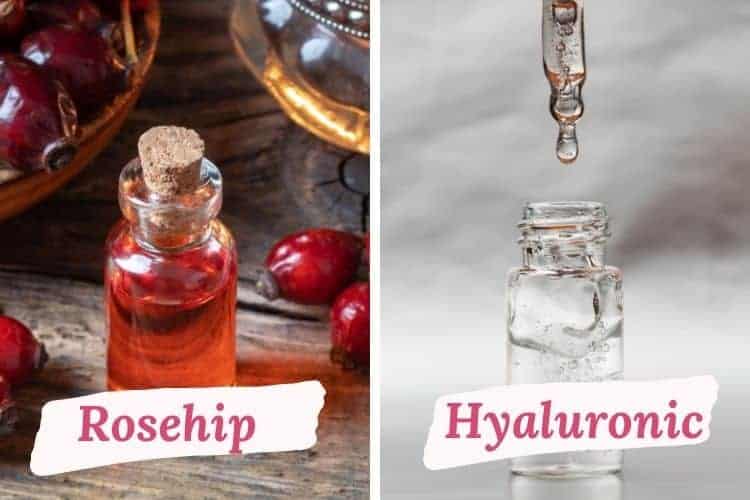
If softer, firmer and more radiant skin are part of your goals, then look no further than the powerhouse combination of rosehip oil and hyaluronic acid. In this guide on rosehip oil vs hyaluronic acid, we’re going to look at:
- Their main benefits and differences.
- How and why you should use them together.
- Products that you can use to get started with these powerhouse ingredients.
Note: this post contains affiliate links and I earn a commission (at no additional cost to you) if you use them to make a purchase.
DOES ROSEHIP OIL CONTAIN HYALURONIC ACID?

There are no studies (that I could find) stating that rosehip oil contains hyaluronic acid. However, rosehip oil might be able to stimulate fibroblasts, which are the cells that produce hyaluronic acid (as well as collagen and elastin).
Please note that I used the phrasing “might be” because this is just an assumption.
This assumption is based on two things:
- vitamin A (which is found in rosehip in the form of beta carotene) plays a role in the production of hyaluronic acid (source). In fact, a study done with rabbit cells suggests that vitamin A stimulates the release of hyaluronic acid.
- rosehip oil has been shown to speed up wound healing in humans (source). Since fibroblasts are a critical part of wound healing, it’s possible that rosehip oil has a stimulatory effect on them.
All that said, we need studies that examine exactly how rosehip oil affects hyaluronic acid production.
MAIN BENEFITS OF ROSEHIP SEED OIL AND HYALURONIC ACID

| ROSEHIP OIL | HYALURONIC ACID |
|---|---|
| Non-comedogenic | Non-comedogenic |
| Occlusive | Humectant |
| Anti-inflammatory | Anti-inflammatory |
| Contains beta-carotene (provitamin A) | n/a |
| Rich in fatty acids and antioxidants (including vitamin E) | n/a |
| Softens wrinkles | Softens wrinkles |
| Supports wound healing | Supports wound healing |
| Suitable for all skin types | Suitable for all skin types |
To start off, let’s look at the main benefits of rosehip oil (1, 2, 3, 4):
- Non-comedogenic: rosehip oil is less likely to clog pores (compared to some other carrier oils). As such, it’s suitable for all skin types, including oily and acne-prone skin.
- Locks in moisture: like all carrier oils, rosehip oil has an occlusive effect. This simply means that it forms a barrier on the skin, which prevents the loss of moisture.
- Rich in antioxidants: the main antioxidants in rosehip oil are carotenoids. And the most abundant of these is beta-carotene, which is converted to retinyl esters (aka preformed vitamin A. Another preformed vitamin A you may be familiar with is retinol).
- Natural source of vitamin E: rosehip oil contains vitamin E in the form of tocopherols and tocotrienols. These compounds have antioxidant properties that protect the skin from free radical damage.
- Improves inflammatory skin conditions: thanks to the presence of fatty acids like linoleic acid, alpha linolenic acid and oleic acid, rosehip oil is able to soothe inflammation. It’s no wonder that rosehip oil is used for conditions like acne, eczema, cheilitis (inflammation of the lips) and neurodermatitis.
- Antimicrobial: one of the antioxidant groups that are present in rosehip oil – phenols – have been shown to have antimicrobial properties.
- Promotes cell turnover: since rosehip oil is a natural source of vitamin A, it can support collagen and elastin production. As a result, rosehip oil is often used as a natural remedy for stretch marks, hyperpigmentation and scars.
Now let’s look at the main benefits of hyaluronic acid (5, 6, 7, 8, 9, 10, 11, 12)
- Humectant: as a humectant, hyaluronic acid is able to attract or bind water. So applying it on the skin means that it draws more water to the skin and helps to keep it hydrated or moisturized. But a word of caution: hyaluronic acid can draw moisture out of your skin if you live in a low humidity environment.
- Essential for maintaining skin structure: hyaluronic acid is a long chain sugar molecule (aka mucopolysaccharide) that is found in the extracellular matrix (together with collagen and elastin). As such, hyaluronic acid plays an important role in the overall look and feel of the skin. In fact, it’s no surprise that hyaluronic injections are used to give the skin a more plump and vibrant look!
- Improves overall appearance of the skin: topical application of hyaluronic acid can help improve the appearance of wrinkles, redness and dermatitis. In addition, taking hyaluronic acid internally can also be beneficial for the skin (since the body produces less of it as we age).
- Facilitates wound healing: topical application of hyaluronic acid has been shown to reduce wound size and the pain associated with wounds.
- Great for all skin types: since hyaluronic acid is non-comedogenic and hydrating, all skin types can benefit from it. In addition, there’s research showing how helpful it can be for:
- Mature skin: a small study showed that hyaluronic acid significantly reduces wrinkles, increases skin hydration and improves both firmness and elasticity in women in their 40s.
- Dry skin: research indicates that using hyaluronic acid together with a moisturizer is much better at improving dry skin, compared to using a moisturizer only.
HOW TO USE ROSEHIP SEED OIL AND HYALURONIC ACID
Since hyaluronic acid provides moisture and rosehip oil locks in moisture, they can be used together. To get the best results, always apply hyaluronic acid first (be it a moisturizer or serum), followed by rosehip oil.
As for the time of day when you can use these ingredients:
- Hyaluronic acid can be used in the morning or evening.
- Rosehip can also be used in the morning or evening. However, some people prefer to use it only in the evening because of the fact that its beta-carotene content is converted to retinol (which can increase photosensitivity).
ROSEHIP OIL VS HYALURONIC ACID: BEST PRODUCTS TO START WITH
1. Rosehip BioRegenerate from Pai
The best quality rosehip oils are made via CO2 (carbon dioxide) extraction and come from the entire rosehip (seed and pulp). This is because the seed is rich in fatty acids while the pulp is rich in beta carotene (provitamin A).
With this in mind, one of the best brands to rely on for rosehip oil is Pai. Their rosehip oil meets all the criteria listed above and contains two bonus ingredients: vitamin E and rosemary extract.
Go here to try Rosehip BioRegenerate.
2. Rosehip Oil from The Ordinary
If you’re looking for a regular rosehip seed oil, then this is a good place to start.
This oil is cold-pressed and rich in fatty acids (since it’s extracted from the seed).
3. Rose Hyaluronic Acid Serum from 100% Pure
With a combination of hyaluronic acid, aloe vera juice (another humectant) and glycerin, this serum is loaded with humectants and skin hydrators.
In addition, it also includes soothing ingredients like rose water and calendula extract that make it suitable for all skin types.
Get this hyaluronic acid serum here.
FAQS ABOUT USING ROSEHIP OIL OR HYALURONIC ACID FOR FACE
Can rosehip oil replace moisturizer?
Since rosehip oil does not contain water (the only source of moisture) and it cannot be used as a substitute for moisturizer. Rather it should be used after applying a moisturizer, to help lock in moisture.
Can I put rosehip oil under my eyes?
Unless you have an allergy to rosehips, the oil is generally safe to use on the skin around the eyes.
CONCLUSION
Rosehip oil and hyaluronic acid are gentle enough for all skin types and they pair together well in any skin care routine.
I hope this article has given you more insight into their benefits and how to get started with them.
You Might Also Like:
How to Choose the Best Rosehip Oil
What To Mix (And Not) With Rosehip Oil For Face – The Ultimate Guide
Rose Oil vs Rosehip Oil for Skin And Hair: Benefits | Which is Better | How To Use
Aloe Vera vs Hyaluronic Acid: Are They Similar? | How to Add to Skincare Routine
Rosehip Oil for Skin: A Complete Guide with Benefits, What to Mix It With, Top Brands and More
Rosehip Oil vs Jojoba Oil for Face (And Body): Which is Better and How To Use
How To Add Rosehip Oil To Your Skin Care Routine: Quick Tips To Follow
The Difference Between Rosehip Oil and Rosehip Seed Oil: Benefits, Which To Use and How to Use
Vitamin C Serum vs Rosehip Oil: Benefits, Which Is Better and How To Use

